About the Expedition
Learn about the historic mission of this Everest Education Expedition and meet the members of the team. Discover why this was such an important scientific endeavor and why so little is known about the geology of Mount Everest.
In Spring 2012, a team of athletes and scientists embarked upon an historic expedition to commemorate the 50th anniversary of the first successful American ascent of Mount Everest.
Several of the team’s climbers, led by mountaineer and author Conrad Anker, sought to retrace the steps of the first American ascent of Mount Everest via the difficult West Ridge. In 1963, two Americans (Tom Hornbein and Willi Unsoeld) became the first to successfully climb Everest’s West Ridge then descend via the Southeast Ridge, thus traversing the entire mountain. This was one of the most difficult high-altitude feats in mountaineering history.
It has not been repeated since 1963. Unfortunately, poor weather conditions on Everest kept the climbers from attempting the West Ridge.Therefore, the team used the Southeast Ridge route to get both up and down the mountain. Concurrently, geologists from Montana State University conducted extensive scientific work on the mountain and shared the science of the Himalaya with students and the public.
The Everest Education Expedition, supported by Montana State University and Montana EPSCoR, placed special emphasis on bringing the excitement of science, discovery, and global adventure into classrooms across Montana and the nation.
Scientific Research
Scientific research on the geology of Mount Everest was a significant component of the Everest Education Expedition, as it was with the first American expedition to Everest in 1963. Previous research in the Everest region is limited in scope due to the obvious difficulties of conducting field work under extreme conditions of elevation and topography. The research agenda was directed towards gaining a better idea of the age of Mount Everest and rocks that comprise the massif; collecting a suite of samples to better date and describe the fossil-bearing marine limestones that form the summit pyramid of Everest; and studying the major faults that cut through Mount Everest to better understand how and when they formed (in particular, the Qomolangma and Lhotse detachment faults). Read more about the scientific research:
- Dave Lageson, a Montana State University geologist, conducted several research projects while part of the expedition and is a grantee of the National Geographic Society. The expedition is sponsored by National Geographic and The North Face with support from Montana State University.
West Ridge Climbers
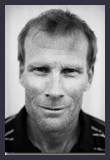
Conrad Anker is an American rock climber, mountaineer, and author famous for his challenging ascents in the high Himalaya and Antarctica. He is a member of The North Face climbing team and has established new routes and first ascents in places around the world such as Zion, Yosemite, the Karakorum, and Alaska. In 1999 he was a key member of the search team which located the remains of legendary British climber George Mallory on Mount Everest. The story behind Conrad finding Mallory's body is documented in the IMAX/National Geographic film The Wildest Dream. He lives in Bozeman, Montana and is an advocate for outdoor recreation and wilderness. His motto is “Be good, be kind, be happy.” Conrad has received a National Geographic grant to carry out this expedition.
![]() Read Conrad's full bio on the North Face website!
Read Conrad's full bio on the North Face website!
![]() National Geographic Expedition Team Member
National Geographic Expedition Team Member
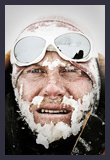
Cory Richards was named one of National Geographic’s Adventures of the Year for 2012. He was the first to climb to the top of Pakistan’s 8035-meter Gasherbrum II in winter, making him the only American to summit any of the world's 8,000 m peaks in winter. The film he made of his adventure – Cold – recently won the grand prize at the Banff Film Festival. Cory is also a photographer for National Geographic magazine. He travels around the world using Boulder, Colorado as his home base. He has a soft spot for Montana and frequently visits his parents in Red Lodge.
![]() Read Cory's full bio on The North Face website!
Read Cory's full bio on The North Face website!
![]() National Geographic Expedition Team Member
National Geographic Expedition Team Member
Southeast Ridge Climbers
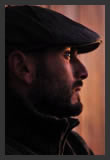
Sam Elias is a climber, skier, and brand ambassador of several outdoor industry companies. He is 29 years old and lives in Boulder, Colorado, but was born in Michigan. Sam climbed for the first time at a summer camp in Colorado when he was 12 years old, however climbing did not consume his life until 2005. Before that, his life's passion was alpine skiing and ski racing, beginning when we was just 2. He enjoys and pursues many styles of climbing including sport and traditional climbing, bouldering, deep water soloing, as well as ice and mixed climbing/dry tooling. He is a very strong advocate for not only climbing, but the outdoor industry as a whole.
![]() Read Sam's full bio on The North Face website!
Read Sam's full bio on The North Face website!
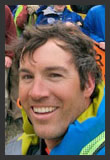
Kristoffer Erickson represents a different breed. Although a photographer by trade (BA from MSU-Bozeman), for more than 15 years Kris has combined his passions for climbing, skiing and photography to document exploration throughout the greater mountain ranges of the world. An accomplished ski-mountaineer and alpinist himself, Kris is an athlete for The North Face and holds first ascents and descents from the Antarctic Peninsula to the Himalaya, including the first ski descent of an 8,000 meter peak by an American male (Cho Oyu, 8201m, 2002). Throughout his travels, Kris has developed a passion for the people of the mountains and has committed to investing a significant amount of his time to philanthropic endeavors that increase the quality of life in remote mountain regions or further opportunities for climbing and exploration in his own community. Kris is most passionate about his work with the Atlas Cultural Foundation, a non-profit he founded with his wife Cloe that helps underserved Moroccans improve their quality of life in the remote regions of the Atlas Mountains. Kris’ recent humanitarian efforts include the Khumbu Climbing School, the Himalayan Cataract Project, the Hans Saari Memorial Fund and the Southwest Montana Climbers’ Coalition.
![]() Read Kris's full bio on The North Face website!
Read Kris's full bio on The North Face website!
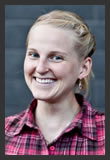
Emily Harrington has been climbing for 15 years and has an impressive list of achievements to show for it. She started as a member of the USA Junior Climbing Team in 1998 and has been a member of the USA Climbing Adult Team (difficulty) since 2004. She was national champion five times and finished 2nd in the Sport Climbing World Championships in 2005. In 2006, she was named Female Climber of the Year at the Teva Mountain Games and attended the Winter Olympic Games in Torino, Italy as a US climbing ambassador. While busy accumulating these athletic achievements, Emily also managed to graduate Magna Cum Laude from the University of Colorado with a Bachelor’s Degree in International Affairs in 2007.
![]() Read Emily's full bio on The North Face website!
Read Emily's full bio on The North Face website!
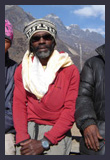
Phil Henderson works as a Utah River Based Manager at the National Outdoor Leadership School where he trains groups for whitewater rafting, kayaking, canoeing and climbing. Phil has worked all his adult life in the recreation industry and has made a career of working in the outdoors. His Career stops have even included assignments in Kenya and Tanzania.
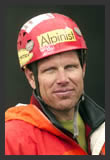
Mark Jenkins is a field staff writer for National Geographic magazine and the Writer-in-Residence at the University of Wyoming. He is the author of four award-winning books: A Man’s Life, The Hard Way, To Timbuktu and Off the Map; and internationally recognized journalist. Mark covers the globe writing about social, environmental and geopolitical issues, from opium smuggling in Afghanistan to HIV/AIDS in Botswana, ethnic cleansing in Burma to mountaineering in Pakistan. Mark's stories have been selected for inclusion in three consecutive Best American Travel Writing anthologies. A resident of Wyoming since the age of seven, Mark does expeditions into the world's last remote regions. Hallmarks include the U.S. Everest North Face Expedition (1986), the first ascent of the highest peaks in the Arctic Circle (1988), the first coast-to-coast crossing of the former Soviet Union by bicycle (1989), and the first descent of the Niger River headwaters in West Africa.
![]() National Geographic Expedition Team Member
National Geographic Expedition Team Member
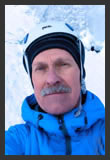
David Lageson is a Professor of Structural Geology and former head of the Department
of Earth Sciences at Montana State University, in his 32nd year of teaching at MSU.
He is a field-based structural geologist with primary interests in brittle deformation
of the upper crust and its sedimentary cover. More specifically, Dave’s research program
over the years has addressed various aspects of the structural architecture and tectonic
evolution of the Rocky Mountains from Montana to Colorado, including duplex thrust
systems and the development of structural culminations, fault reactivation and inversion
tectonics, fault zone diagenesis, active tectonics and earthquake geology, structurally-controlled
pluton emplacement in fold-and-thrust belts, and more recently, fracture and fault
studies associated with subsurface carbon sequestration projects. At Mount Everest
(Qomolangma), Dave will be studying the rocks that comprise Everest and nearby peaks
in order to better understand the geologic evolution of this amazing region, with
particular emphasis on the major tectonic faults in the area. Dave has received a National Geographic grant that enables him to conduct the geological research of Everest.
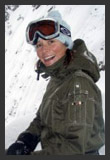
Hilaree O'Neill has been named by Outside magazine as one of the most adventurous women in the world of sports. She’s skied from the Himalayan summit of Cho Oyu in Tibet and climbed and skied several high peaks in Bolivia and Argentina. Elsewhere, she’s cut turns on remote volcanoes in the Kamchatka Peninsula of Russia, in Mongolia, Pakistan, Lebanon, as well as many first descents in the tight couloirs of Baffin Island. Born and raised in the Pacific Northwest, Hilaree began skiing at age 3. Hilaree now calls Telluride, Colorado her home. As a mother to two young boys, Hilaree’s life has changed rather dramatically, yet her passion for the mountains has not abated. She continues to work as a guide for the local heli-skiing outfit – Helitrax and continues to travel and do ski mountaineering.
![]() Read Hilaree's full bio on The North Face website!
Read Hilaree's full bio on The North Face website!
Base Camp Support
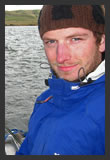
Travis Corthouts
Travis Corthouts is studying structural geology at Montana State University as a graduate student of Professor David Lageson. His pursuit of structural geology stems from his lifelong interest of mountains and how they are formed. While in the Himalayas on this expedition, Travis hopes to conduct research that will serve as the basis for a master’s thesis on the petrology and structural geology of rocks from the Everest-Nupste-Lhotse massif. Travis has been an avid skier his whole life and a climber/mountaineer for nine years. Some of his mountaineering experiences consist of several winter ascents of Mt. Washington via Huntington Ravine; multiple peaks in the Cordillera Blanca of Peru; and a winter ascent of Montana’s Granite peak. He does various forms of rock climbing including traditional, sport and bouldering, but enjoys sport-climbing the most. Travis likes traveling and photography and loves doing them both at once. He grew up in Canton Connecticut, but loves the Rocky Mountain west and continues to always find his way back there.
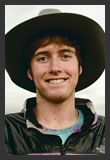
Max Lowe
Max Lowe is an action sports event and documentary photographer based out of Bozeman, Montana. He grew up in Bozeman, graduating from Bozeman High School in 2007. He began working as a photographer when at University in Salt Lake City, and has done journalism work and photo work for companies such as The Big Sky Journal, Salt Lake Underground Magazine, The North Face and Black Diamond. He has traveled across the world with his family and worked with the Everest expedition as a National Geographic Young Explorer.

